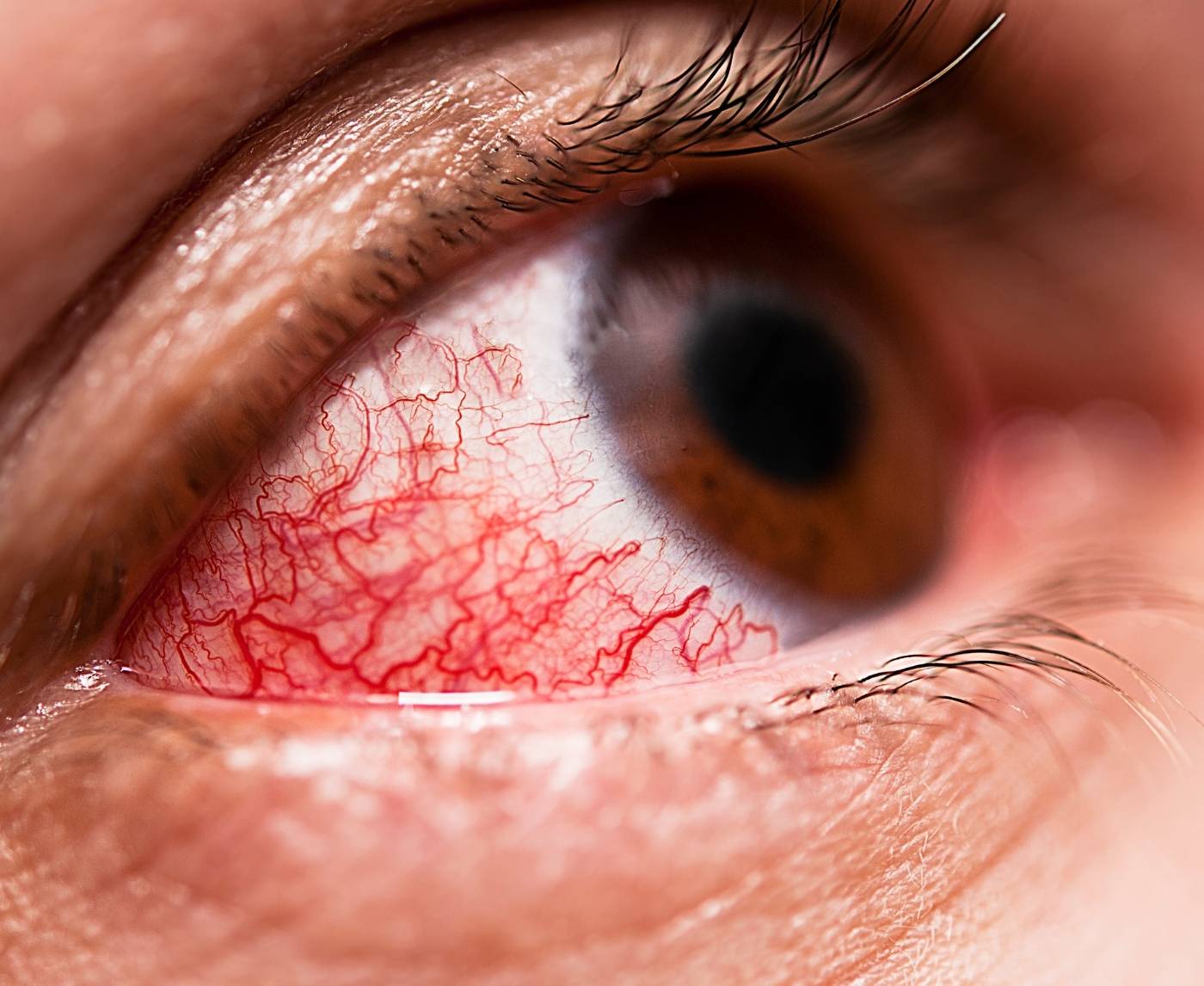Quick Answer: Yes, several STDs, especially gonorrhea, chlamydia, herpes, and even syphilis, can infect your eye. If your eye swelled shut after sex, get tested ASAP and avoid touching or rubbing it.
When Sex Makes Your Eye Swell Shut: A Hidden STD Symptom
It sounds dramatic, maybe even ridiculous. Your eye swelled shut after sex? But this isn’t a joke or urban legend. Sexually transmitted infections can absolutely show up in the eye, sometimes in explosive ways.
The medical term? Ocular STI, or gonococcal conjunctivitis if caused by gonorrhea. The most common routes of infection include:
- Oral sex with ejaculation near or in the eye
- Touching your genitals or a partner’s fluids, then touching your eye
- Infected towels, contact lenses, or fingers
Unlike seasonal allergies or typical pink eye, an STD in the eye is often:
- Sudden and severe
- Accompanied by thick yellow or green discharge
- Painful or sensitive to light
- Associated with other STD symptoms (discharge, burning, sore throat)
This isn’t a story about “you’re dirty.” It’s a reminder that STDs can live outside of where we expect them to, and they don’t care if you used a condom for penetration. If your eye is acting up after sex, especially within 48 hours, you owe it to yourself to check for more than pollen.

People are also reading: This Common STD Could Be Why Your Testicles Hurt
The STD Offenders: Which Infections Cause Eye Symptoms?
Several STDs can cause eye infections, but some are sneakier than others.
Gonorrhea
Nicknamed “the drip” for a reason, gonorrhea in the eye can cause a violent, rapid-onset pink eye. Expect:
- Profuse yellow discharge
- Crusting shut of the eyelids
- Swelling that can be severe enough to close the eye
- Pain, redness, and blurred vision
Transmission can happen from semen or vaginal fluids entering the eye during sex, or via hand-to-eye contact.
Chlamydia
Less dramatic, but just as dangerous over time. Chlamydia trachomatis can cause follicular conjunctivitis, with:
- Mild discharge
- Redness and irritation
- Gritty or itchy feeling
- Chronic symptoms if untreated
It’s often misdiagnosed as seasonal allergies, leading to months of eye drops with no relief.
Herpes Simplex Virus (HSV-1 or HSV-2)
Herpes isn’t just for lips or genitals. Ocular herpes can cause:
- Blister-like lesions on or around the eye
- Light sensitivity
- Scarring of the cornea (in serious cases)
- Recurring outbreaks triggered by stress or sun exposure
Syphilis and HIV can also affect the eye, though more rarely. Syphilis, in particular, is known as the “great imitator” because it can look like almost any eye condition, from uveitis to optic neuritis.
Not Just Pink Eye: Why It Gets Misdiagnosed
Many people, and sometimes even doctors, don’t immediately suspect an STD when the eye is involved. Why? Because it looks a lot like:
- Allergies
- Standard bacterial conjunctivitis
- A scratched cornea
- A bad reaction to contact lenses or makeup
But here’s the difference:
- STD-related conjunctivitis often appears suddenly after sexual contact
- It’s more likely to produce thick, pus-like discharge, not just watery irritation
- It may be resistant to regular antibiotic eye drops
- It may be accompanied by other systemic symptoms (fever, swollen lymph nodes, genital discomfort)
If your eye issue came within 1, 3 days of sexual activity and it’s not responding to usual treatments, it’s time to stop guessing and get tested.
Check Your STD Status in Minutes
Test at Home with Remedium3-in-1 STD Test Kit

 For Men & Women
For Men & Women Results in Minutes
Results in Minutes No Lab Needed
No Lab Needed Private & Discreet
Private & DiscreetOrder Now $69.00 $147.00
For all 3 tests
Case Study: “My Eye Swelled Shut After A Hookup, Turns Out It Was Gonorrhea”
Talia, 26, had a casual hookup. There was oral, a little face-sitting, no direct eye contact with fluids, so she thought.
“I woke up the next day and my left eye was glued shut. I thought it was mascara build-up or cat allergies. But the swelling got worse by the hour.”
She went to urgent care. They diagnosed her with bacterial pink eye, gave her eye drops, and sent her home. It got worse. After calling a sexual health clinic, she took a urine and swab test. Two days later: gonorrhea positive.
“I had no other symptoms. No genital discharge, no burning. Just the eye,” she says. “I would’ve never guessed.”
With proper antibiotic treatment, the eye infection cleared, but the lesson stuck.
Stats You Should Know: Ocular STDs Aren’t Rare Anymore
Think eye STDs are rare? Think again.
Thanks to rising STI rates, especially in younger adults and among people with multiple partners or who engage in oral/anal sex, we’re seeing more ocular infections than ever before. Here’s what the data says:
- According to the CDC, gonorrhea rates rose by 25% in the past five years, and up to 1% of cases include eye infections.
- Chlamydia remains the most reported STI in the U.S., with over 1.6 million cases annually.
- Though underreported, ocular chlamydia occurs most often in sexually active individuals aged 15, 29.
- In a 2023 PubMed review, ocular gonorrhea was classified as a "re-emerging clinical concern" due to antibiotic resistance and high reinfection rates.
Herpes simplex keratitis (eye herpes) is one of the leading causes of infectious blindness in developed countries, according to the American Academy of Ophthalmology. And yet, how often do you hear about eye infections after sex? Probably never. This silence is part of the problem.
What Experts Say: Don’t Ignore Your Eye (Or Your Gut)
Most people don’t realize how serious an untreated ocular STD can be.
Dr. Helena Moss, an infectious disease specialist, puts it plainly:
“Ocular gonorrhea can cause corneal ulceration and even perforation if left untreated. It’s not just a cosmetic issue, it’s an urgent medical one.”
She also notes that misdiagnosis is common:
“We get patients who’ve been on the wrong eye drops for a week or more. The infection spreads, and they lose vision. A simple sexual history and test could’ve changed everything.”
Dr. Moss recommends:
- Asking your doctor if an STD could be the cause
- Requesting an STD test that includes throat and eye swabs if you've had oral sex
- Avoiding self-medicating with leftover antibiotics or drops

People are also reading: The STD That Looks Like Pink Eye But Can Melt Your Cornea
Home Testing: Yes, You Can Catch This Early
You don’t need to wait for your eye to ooze shut before doing something. If you’ve had a recent sexual encounter and now have:
- Eye redness, swelling, or pain
- Discharge (especially yellow or green)
- Light sensitivity or crusting
- No relief from allergy drops
…it’s time to test. Fast. Thanks to modern at-home kits, you can check for multiple infections discreetly. Here’s what we recommend:
- Chlamydia, Gonorrhea & Syphilis 3-in-1 Rapid Test Kit: Tests for Gonorrhea, Chlamydia, and Syphilis
- Chlamydia & Gonorrhea 2-in-1 At-Home Rapid Test Kit: Perfect if eye discharge is your only symptom
- Women’s 10-in-1 STD At-Home Rapid Test Kit: Full menu of single and multi-STD kits, shipped discreetly
Many people feel too embarrassed to bring up eye symptoms in a sexual health clinic. Testing at home gives you control, privacy, and speed.
Let’s Bust Some Myths: “But I Didn’t Get Ejaculated On!”
There’s a persistent myth that you can only get eye infections from direct ejaculation into the eye. That’s false. You can get an STD in the eye from:
- Touching infected fluids, then rubbing your eye
- Face-sitting, oral play, or using a sex toy
- Kissing someone with oral herpes then touching your eyelid
- Sharing contaminated towels, contact lens cases, or pillows
Some people even get infected from their own fluids if they’re unaware they’re carrying gonorrhea or chlamydia genitally. All it takes is poor hand hygiene and a quick eye rub. Don’t rule yourself out just because you wore a condom. STDs don’t need vaginal penetration to spread.
Check Your STD Status in Minutes
Test at Home with Remedium7-in-1 STD Test Kit

 For Men & Women
For Men & Women Results in Minutes
Results in Minutes No Lab Needed
No Lab Needed Private & Discreet
Private & DiscreetOrder Now $129.00 $343.00
For all 7 tests
What Happens If You Ignore It?
Left untreated, an STD in the eye isn’t just uncomfortable; it can be dangerous. Here’s what could happen:
- Vision loss or blindness, especially with herpes or untreated gonorrhea
- Corneal ulcers that require surgical treatment
- Spread of infection to other parts of the body
- Prolonged symptoms that mimic allergies or chronic dry eye
In one case reported by the Journal of Clinical Ophthalmology, a man with untreated gonococcal conjunctivitis developed perforation of the cornea within 5 days.
Early testing = early treatment = no regrets.
How to Protect Yourself: Sex Hygiene for Your Eyes (Yes, Really)
We talk a lot about condoms and STI prevention, but rarely about how to protect your eyes during sex. If that sounds weird, it’s because no one teaches it. But the risk is real, and prevention is easier than you think. Here’s how to reduce the risk of ocular STDs:
- Wash your hands before and after sex,especially if you touch fluids, toys, or genitals
- Use a clean towel or tissue for cleanup; never wipe your eyes with the same cloth used on genitals
- Communicate about symptoms. If your partner has redness, discharge, or oral cold sores, steer clear of face play
- Avoid sharing eye makeup or contact lenses; these items can trap bacteria or viruses
- Consider protective eyewear (yes, really), Especially during sex acts involving ejaculation near the face
The bottom line? You protect your body during sex, start thinking about your face and eyes, too.
Talking to Your Partner: The Awkward But Necessary Part
Imagine having to text someone: “Hey, did your fluids get in my eye?” It sounds ridiculous, but it might be the most important health convo you’ll ever have.
Tips for breaking the news or asking the question:
- Keep it neutral: “Hey, this is random but my eye got super swollen after we hooked up. I’m checking with a doc, have you ever had anything like this?”
- Don’t assume blame or shame: “I’m not accusing, just trying to rule things out.”
- Offer to test together or share your results if you already tested
- Set boundaries for future encounters until things are cleared
Most people will respond better than you fear. And if they don’t? You just got more useful data about who they are.

People are also reading: How Often Do You Actually Need to Wash Your Sex Toys?
Future Trends: More Awareness, Better Testing, Less Shame
The medical world is finally catching up to the idea that STDs affect more than just genitals. We’re starting to see:
- Better multi-site STD testing that includes oral, rectal, and eye swabs
- Telehealth STI consults where patients can show symptoms via video
- Wider use of at-home tests, especially for those in sexual health deserts
- More inclusive sex ed that covers things like herpes in the eye or gonorrhea in the throat
And with social media, more people are sharing stories like “my eye swelled shut after sex”, breaking the taboo, one awkward tale at a time.
Common Misconceptions That Delay Treatment
Let’s knock out a few stubborn myths:
“I didn’t have sex, just oral.”
Oral sex transmits STDs, including ones that can infect the eye. Semen or vaginal fluid carries bacteria, and eye tissue is highly absorbent.
“It’s just pink eye, I get it every spring.”
If it showed up after sex, is painful, and isn’t going away with OTC drops, it’s not allergies. It’s time to test.
“It’s only on one side, so it can’t be an STD.”
Many STD eye infections start on one side but can spread fast if untreated.
“STDs can’t live in the eye.”
They can. They do. And they thrive in mucous membranes, including your conjunctiva.
“I don’t feel sick otherwise.”
Some of the most dangerous infections are asymptomatic elsewhere. The eye may be your only clue.
FAQs
1. Can STDs really infect your eye?
Yes. STDs like gonorrhea, chlamydia, herpes, and syphilis can infect the eye, usually through direct contact with infected fluids or contaminated hands.
2. How soon after sex can an eye infection show up?
Symptoms can appear within 24, 72 hours after exposure. If your eye swells, turns red, or starts leaking discharge soon after sex, take it seriously.
3. Can I get eye gonorrhea from oral sex?
Absolutely. Ejaculate or vaginal fluids near the eye, even unintentionally, can lead to ocular gonorrhea or chlamydia.
4. Is STD pink eye different from regular pink eye?
Yes. STD-related conjunctivitis often involves more severe swelling, thicker discharge, and resistance to normal pink eye treatments.
5. Can I test for an STD that’s only in my eye?
Yes, but you’ll need a test that allows for site-specific swabs, or start with a urine or combo test and share symptoms with a provider.
6. Do I need antibiotics if it’s gonorrhea in my eye?
Yes, and urgently. Ocular gonorrhea requires prompt treatment with systemic and topical antibiotics to avoid vision damage.
7. What happens if I ignore an STD eye infection?
You risk serious complications, including corneal ulcers, blindness, or the spread of infection to other areas of the body.
8. Can I get reinfected if I don’t treat my partner?
Definitely. Treating yourself without informing or testing your partner leads to a frustrating and dangerous cycle of reinfection.
9. Can herpes cause swelling in just one eye?
Yes. Herpes in the eye often starts unilaterally and can cause redness, blistering, and even blurred vision or scarring if untreated.
10. Can I wear contact lenses during an eye STD infection?
No. Remove them immediately. Contacts can worsen the infection, spread bacteria, and delay healing.
Your Eye Isn’t Overreacting; It’s Warning You
If your eye swelled shut after sex, don’t laugh it off. Don’t wait it out. And please, don’t self-treat it with leftover allergy drops.
Your eye is trying to tell you something. Whether it's gonorrhea, chlamydia, or herpes, the solution starts with knowing. And that starts with testing.
Sources
1. Chlamydial Conjunctivitis: Symptoms, Transmission, and More – Medical News Today
2. Chlamydia in the Eye: Pictures, Causes, Treatment & More – Healthline










